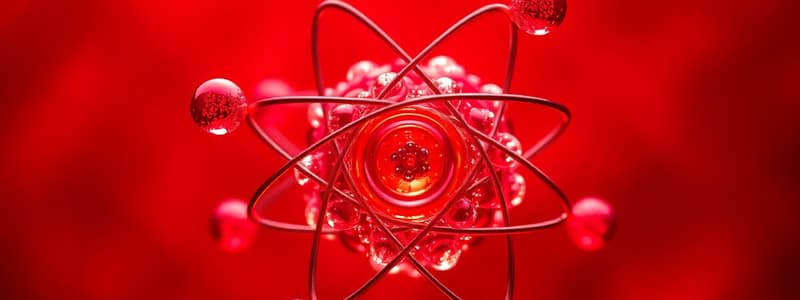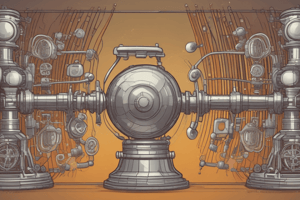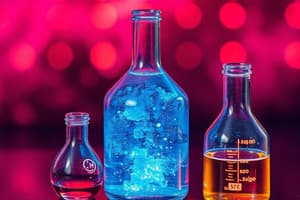Podcast
Questions and Answers
Which subatomic particle determines the atomic number of an element?
Which subatomic particle determines the atomic number of an element?
- Photon
- Electron
- Neutron
- Proton (correct)
Isotopes of an element have the same number of neutrons but a different number of protons.
Isotopes of an element have the same number of neutrons but a different number of protons.
False (B)
What is the name of the model proposed by J.J. Thomson, describing electrons scattered within a positively charged substance?
What is the name of the model proposed by J.J. Thomson, describing electrons scattered within a positively charged substance?
Plum Pudding Model
Elements in Group 17 of the periodic table, known as __________, are highly reactive non-metals that readily form salts with metals.
Elements in Group 17 of the periodic table, known as __________, are highly reactive non-metals that readily form salts with metals.
Match the following scientists with their contributions to the atomic model:
Match the following scientists with their contributions to the atomic model:
Which periodic trend describes the ability of an atom to attract electrons in a chemical bond?
Which periodic trend describes the ability of an atom to attract electrons in a chemical bond?
Atomic radius increases across a period from left to right on the periodic table.
Atomic radius increases across a period from left to right on the periodic table.
What is the term for atoms of the same element with different numbers of neutrons?
What is the term for atoms of the same element with different numbers of neutrons?
__________ is a radioisotope used in radiocarbon dating to determine the age of organic materials.
__________ is a radioisotope used in radiocarbon dating to determine the age of organic materials.
Match the following elements with their primary uses:
Match the following elements with their primary uses:
Which group of elements is known for being mostly unreactive due to full outer electron shells?
Which group of elements is known for being mostly unreactive due to full outer electron shells?
Neutrons contribute to the atomic number of an element.
Neutrons contribute to the atomic number of an element.
What occurs when an unstable nucleus releases radiation in the form of alpha, beta, or gamma rays?
What occurs when an unstable nucleus releases radiation in the form of alpha, beta, or gamma rays?
The __________ conducted by Ernest Rutherford, demonstrated that atoms have a small, dense, positively charged nucleus.
The __________ conducted by Ernest Rutherford, demonstrated that atoms have a small, dense, positively charged nucleus.
Match each element with its characteristic property or use:
Match each element with its characteristic property or use:
Which group 1 element reacts violently with water?
Which group 1 element reacts violently with water?
The number of protons in an atom can vary for a given element, creating different isotopes.
The number of protons in an atom can vary for a given element, creating different isotopes.
In the Bohr model, what do electrons orbit in around the nucleus?
In the Bohr model, what do electrons orbit in around the nucleus?
In the periodic table, elements are organized by increasing ________ number.
In the periodic table, elements are organized by increasing ________ number.
Match the scientists with their discoveries related to atomic structure:
Match the scientists with their discoveries related to atomic structure:
Flashcards
Proton (p⁺)
Proton (p⁺)
Positively charged particle located in the nucleus of an atom. Determines the atomic number.
Neutron (n⁰)
Neutron (n⁰)
Neutral particle located in the nucleus of an atom. Contributes to the mass number.
Electron (e⁻)
Electron (e⁻)
Negatively charged particle orbiting the nucleus. Much smaller than protons and neutrons.
Isotopes
Isotopes
Signup and view all the flashcards
Radioisotopes
Radioisotopes
Signup and view all the flashcards
Billiard Ball Model
Billiard Ball Model
Signup and view all the flashcards
Plum Pudding Model
Plum Pudding Model
Signup and view all the flashcards
Nuclear Model
Nuclear Model
Signup and view all the flashcards
Bohr Model
Bohr Model
Signup and view all the flashcards
Quantum Model
Quantum Model
Signup and view all the flashcards
Groups (Periodic Table)
Groups (Periodic Table)
Signup and view all the flashcards
Alkali Metals (Group 1)
Alkali Metals (Group 1)
Signup and view all the flashcards
Alkaline Earth Metals (Group 2)
Alkaline Earth Metals (Group 2)
Signup and view all the flashcards
Transition Metals (Groups 3-12)
Transition Metals (Groups 3-12)
Signup and view all the flashcards
Halogens (Group 17)
Halogens (Group 17)
Signup and view all the flashcards
Noble Gases (Group 18)
Noble Gases (Group 18)
Signup and view all the flashcards
Atomic Radius Trend
Atomic Radius Trend
Signup and view all the flashcards
Electronegativity Trend
Electronegativity Trend
Signup and view all the flashcards
Ionization Energy Trend
Ionization Energy Trend
Signup and view all the flashcards
Hydrogen (H)
Hydrogen (H)
Signup and view all the flashcards
Study Notes
Atomic Structure & Subatomic Particles
- Atoms consist of protons, neutrons, and electrons.
- Protons (p⁺) possess a positive charge and reside in the nucleus; the quantity of protons defines the atomic number (Z) of an element.
- Neutrons (n⁰) are uncharged particles located in the nucleus, contributing to the mass number (A).
- Electrons (e⁻) have a negative charge and move around the nucleus in electron clouds (orbitals); electrons are much smaller than protons and neutrons.
- Isotopes arise from variations in neutron number within atoms of the same element.
- Neutrons = Mass Number - Atomic Number
Isotopes & Radioisotopes
- Isotopes are variants of an element with the same proton number but differing neutron numbers, thus having different mass numbers.
- Carbon-12 (C-12) contains 6 protons and 6 neutrons.
- Carbon-14 (C-14) contains 6 protons and 8 neutrons.
- Radioisotopes are unstable isotopes that emit radiation over time.
- Carbon-14 serves in radiocarbon dating for determining fossil ages.
- Uranium-235 is utilized in nuclear power plants and atomic bombs.
- Iodine-131 is employed in treating thyroid cancer.
- Cobalt-60 is utilized in radiotherapy for cancer treatment.
- Radioactive decay involves an unstable nucleus emitting alpha (α), beta (β), or gamma (γ) rays.
Atomic Models & Their Creators
- John Dalton (1803) proposed the Billiard Ball Model: atoms are solid, indivisible spheres.
- J.J. Thomson (1897) discovered the electron and proposed the Plum Pudding Model: electrons scattered within a positively charged "pudding."
- Ernest Rutherford (1911) performed the Gold Foil Experiment, finding that atoms have a small, dense, positively charged nucleus surrounded by empty space and proposed the Nuclear Model.
- Niels Bohr (1913) refined the model to the Bohr Model: electrons orbit the nucleus in fixed energy levels (shells).
- Erwin Schrödinger (1926) introduced the Quantum Model: electrons exist in probability clouds (orbitals) rather than fixed paths.
- James Chadwick (1932) discovered the neutron, explaining isotopes (different masses of the same element).
- Rutherford's Gold Foil Experiment demonstrated that atoms are mostly empty space with a small, dense nucleus, as some alpha particles were deflected.
Periodic Table Overview
- The periodic table orders elements by atomic number and groups them by chemical properties.
- Elements in the same group (column) share similar valence electron numbers, determining their reactivity.
- Alkali Metals (Group 1: Li, Na, K, Rb, Cs, Fr) are extremely reactive with 1 valence electron, react violently with water, and have soft textures and low melting points.
- Alkaline Earth Metals (Group 2: Be, Mg, Ca, Sr, Ba, Ra) are less reactive than Group 1, possess 2 valence electrons, and are found in bones and fireworks.
- Transition Metals (Groups 3-12: Fe, Cu, Ag, Au, etc.) are hard, dense, have high melting points and good conductivity, form colored compounds, and exhibit multiple oxidation states.
- Halogens (Group 17: F, Cl, Br, I, At) are highly reactive non-metals with 7 valence electrons, form salts with metals (e.g., NaCl), and exist in various states at room temperature.
- Noble Gases (Group 18: He, Ne, Ar, Kr, Xe, Rn) are unreactive due to full outer electron shells and are used in neon signs and balloons.
- Metalloids (B, Si, Ge, As, Sb, Te) are found along the staircase and have properties of both metals and non-metals.
- Silicon (Si) is a key semiconductor element.
Periodic Table Trends
- Atomic Radius (Size) increases down a group due to added electron shells.
- Atomic Radius (Size) decreases across a period because the nucleus pulls electrons closer.
- Electronegativity (Ability to attract electrons) increases across a period (except noble gases).
- Electronegativity (Ability to attract electrons) decreases down a group as atoms get larger.
- Ionization Energy (Energy to remove an electron) increases across a period as nuclear attraction strengthens.
- Ionization Energy (Energy to remove an electron) decreases down a group as electrons are farther from the nucleus.
Common Elements & Their Uses
- Hydrogen (H) is the most abundant element, used in fuel and water.
- Oxygen (O) is essential for respiration and combustion.
- Carbon (C) is the basis of organic life and is found in diamonds and coal.
- Iron (Fe) is used in steel production and blood hemoglobin.
- Copper (Cu) is used in electrical wiring due to its conductivity.
- Gold (Au) and Silver (Ag) are used in jewelry and electronics.
- Uranium (U) is used in nuclear energy production.
Studying That Suits You
Use AI to generate personalized quizzes and flashcards to suit your learning preferences.




